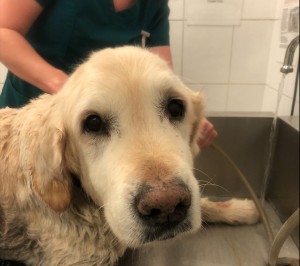News
Pet of the month – November – Kim
by admin on November 1st, 2018
Category: Pet of the Month, Tags:
Pet of the month for November is Kim, a 14 year old Golden Retriever, seen here having her weekly bath. Kim has suffered from an underactive thyroid for some years and despite longterm supplementation with thyroid hormone still suffers from a flaky skin, which is a common symptom. Other than that the condition is being well managed.
What is hypothyroidism?
Hypothyroidism develops when the thyroid gland function falls below normal. In dogs and cats the two thyroid gland lobes lie on either side of the windpipe and produce thyroid hormone. This hormone controls the speed at which the body’s metabolism works. In patients with hypothyroidism, not enough of the hormone is produced. As a result the metabolism ‘slows down’, and, with time, this can affect almost all the organs of the body.
Hypothyroidism is common in adult dogs, but is very rare in cats.
How do animals get hypothyroidism?
In the majority of cases hypothyroidism is diagnosed in adult dogs that have previously been healthy. In most dogs the disease either develops due to the affected animal’s own immune system attacking the thyroid gland (‘lymphocytic thyroiditis’) or due to degeneration of the gland tissue. It is possible that both forms of the condition may in fact represent the same disease process. Over time, more and more thyroid tissue is destroyed until the gland cannot function any longer.
It is still not known why dogs develop this disease. Certain breeds of dogs are more susceptible to hypothyroidism – these include Retriever breeds, Doberman Pinscher, Setters, Terrier breeds and Spaniels (especially Cocker Spaniels). Hypothyroidism is rare in toy and miniature breeds. Several factors have been proposed that could trigger the immune reaction, but so far nothing has been proven.
Hypothyroidism is extremely rare in cats, but can very occasionally be seen after zealous treatment of an overactive thyroid gland.
In rare cases puppies and kittens are born without a functioning thyroid gland.
What are the clinical signs of hypothyroidism?
As the disease affects the whole metabolism, clinical signs are often vague and non-specific and can affect almost every aspect of the dog’s body. The disease can also mimic many other problems.
Many dogs are presented with weight gain and lethargy or lack of interest in activities they previously enjoyed. However, the majority of dogs presented because of weight gain are simply overweight because they eat too much (See Nutrition advice for dogs information sheet).
Often a ‘tragic expression’ of the face is noticed by owners of dogs with hypothyroidism, and this is due to thickening of the skin and loss of tone of facial muscles. A dull coat, greasy or darkened skin and hair loss, especially on the sides of the body and the tail, are also frequently noticed. Constipation can develop, although diarrhoea is also a possible problem because the immune system is less effective. This reduction in immunity can also lead to other infections such as chronic skin or ear problems. Less commonly, more severe clinical signs can be seen, such as those related to nerve function problems.
Hypothyroidism is not usually fatal, but it can compromise an affected dog’s quality of life.
Puppies and kittens born without a functioning thyroid gland do not grow properly and their mental development may be affected. Many of these patients do not survive, and those which do often suffer from chronic arthritis because of abnormal joint development.
Adult cats with hypothyroidism show similar signs to dogs, but such cases have only very rarely been reported.
How is the disease diagnosed?
Hypothyroidism is diagnosed by blood testing – the amount of thyroid hormone in the blood as well as the amount of TSH (a hormone that controls the function of the thyroid gland) is measured. However, further blood values are also looked at in order to test for other diseases, because the clinical signs of thyroid disease are not usually very specific. Depending on the individual case it may also be necessary to analyse a urine sample or even to perform further tests such as radiography (X-rays) or ultrasound examination.
If other diseases can be ruled out and the blood values show low thyroid hormone, then a diagnosis of hypothyroidism can be straightforward. However, not all blood tests results lead to a clear-cut diagnosis as thyroid hormone measurement can be influenced by a variety of other factors. In such cases it may be necessary to perform further blood tests, or in some cases to re-test after several weeks or months to confirm the disease. In some cases the diagnosis of hypothyroidism can be quite problematic.
Can hypothyroidism be treated?
Once hypothyroidism has been diagnosed, it can be readily treated with tablets containing thyroid hormone. The condition can be controlled rather than cured, and life-long medication has to be given to provide the body with thyroid hormone. As the required dose can change over time, repeat blood tests are necessary at intervals to check the level of hormone in the blood.
The clinical signs of hypothyroidism will improve with treatment but it can take several months for all the signs to resolve.
My pet has hypothyroidism, what is the outlook?
Once a pet is stabilised on medication, it will not be noticeable to anyone – including the animal – that he or she actually has a chronic disease. Pets with hypothyroidism that are on therapy have an excellent prognosis and can expect to live a normal life, as long as they receive medication and are properly managed with the help of your veterinary surgeon.
Responses are currently closed, but you can trackback from your own site.


